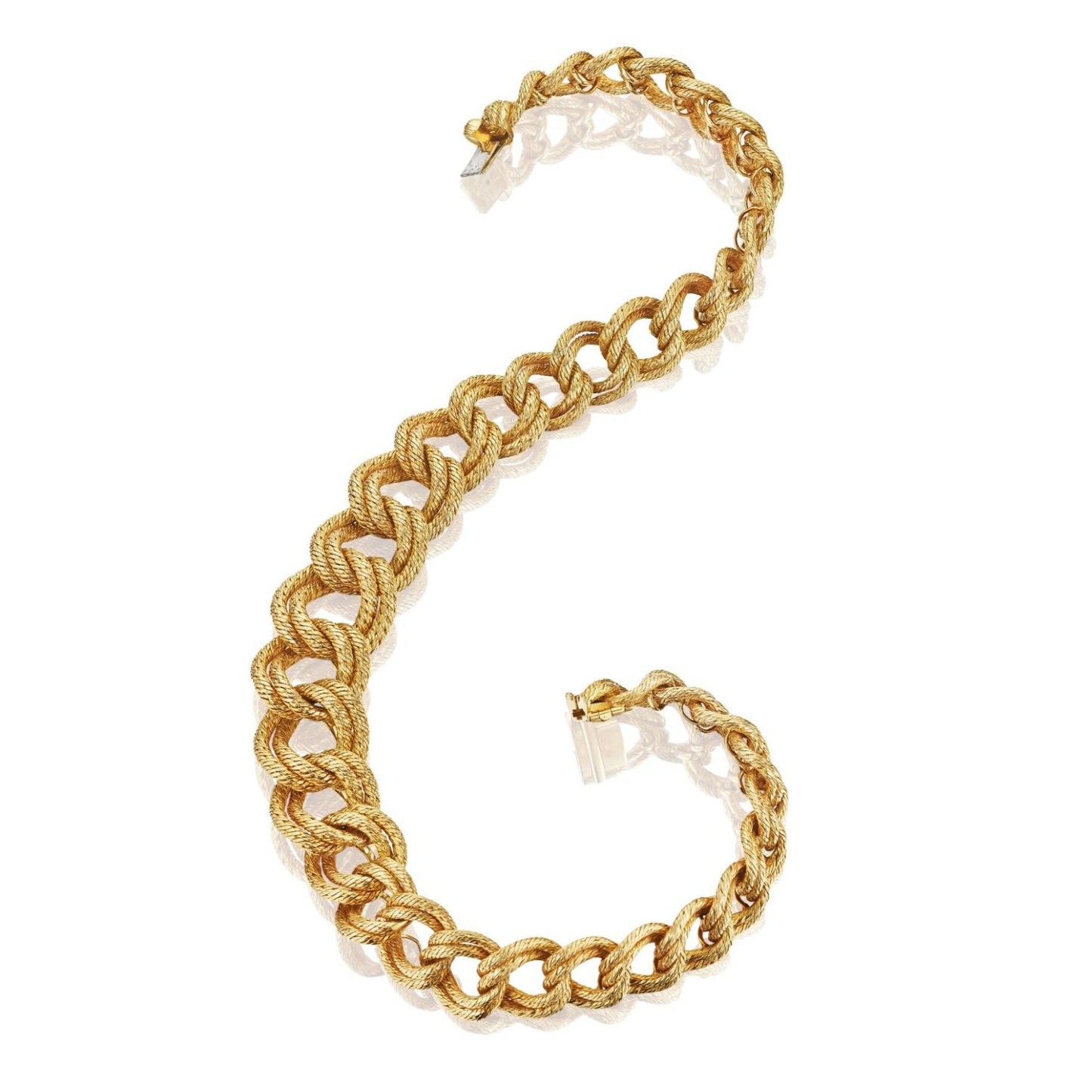GOLD “PAILLETTE” DOUBLE CURB LINK NECKLACE BY VAN CLEEF & ARPELS, PARIS, CIRCA 1950, MANUFACTURED BY JACQUES LENFANT FOR GEORGES LENFANT
GOLD “PAILLETTE” DOUBLE CURB LINK NECKLACE BY VAN CLEEF & ARPELS, PARIS, CIRCA 1950, MANUFACTURED BY JACQUES LENFANT FOR GEORGES LENFANT
A necklace composed of braided gold interlocking rings, graduating in size; 18-karat gold, with French assay marks; in original signed box
- Signed VCA B3303 with maker’s mark for Georges Lenfant
- Circumference: 15 inches
Additional cataloguing
Biography
Van Cleef & Arpels was founded in 1906 by Alfred Van Cleef and his two brothers-in-law, Charles and Julian Arpels, at 22 Place Vendôme, Paris. Their important design innovations include the invisible setting, the minaudière and the Zip necklace. In 1939, they opened an office in Rockefeller Center in New York, moving three years later to 744 Fifth Avenue where they are today. Their impressive client list includes royalty, socialites, and Hollywood stars such as Jackie Kennedy, Princess Grace, Liz Taylor, and the Duchess of Windsor. In 1999, Van Cleef & Arpels became part of the Richemont Group. They have locations in the Americas, Europe, and Asia.
Significance
For thousands of years, elaborate gold chains have been a mark of power and loyalty. Since the Middle Ages in England, the livery collar, or chain of office, typically a thick gold chain, has been draped across the shoulders of rulers and was favored by Henry VIII. His first wife, Catherine of Aragon was painted in the fifteenth century wearing a surprisingly modern gold chain link necklace. Gold has been a favored metal for its beautiful warm color, its durability, and rarity.
During the 1950s the gold necklace became an important wardrobe staple. The privation of the years during World War II meant that jewelers had to innovate with the materials they had on hand, platinum was not obtainable, and stones were difficult to get. The finest houses rose to the challenge, and Van Cleef & Arpels entered the 1950s with innovative new designs in gold that were wearable for any occasion. A well-designed gold necklace was a worthy investment. For this necklace, they turned to the most important maker of gold pieces, the Lenfant workshop. From the 1950s to the 1970s, Jacques Lenfant created superb goldwork, with each necklace and bracelet more complex than the last. He was highly sought-after by the great French houses including Cartier, Hermes, and Van Cleef & Arpels. His work explored movement and texture and this necklace features his iconic woven “paillette” texture meaning sequins, acknowledging the way the chain glitters in the light. The beautifully constructed chain features doubled links that graduate in size, a beautiful and powerful design.
Lenfant looked at chains as a “harmony of sounds, shapes and textures” as he wrote in his book Le livre de la chaîne. He referred to the “rustle of rolling parts, which slide against each other [like] chain bells” and said that jewels should be “in every gesture of life.” By considering the construction of chains from all the senses, Lenfant created masterpieces, as shown by this exquisite necklace for Van Cleef & Arpels. It is a rare and desirable addition to any collection.







